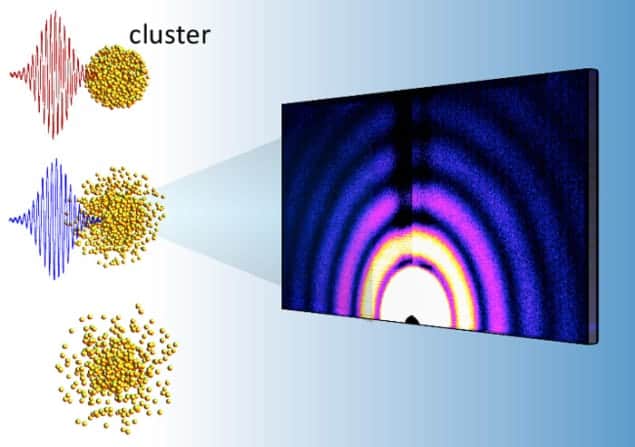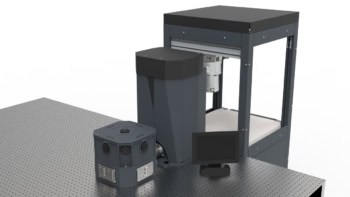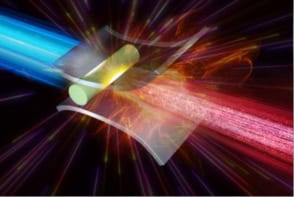
The first nanometre-scale images of matter at femtosecond temporal resolution have been taken by scientists working at the Linac Coherent Light Source (LCLS) at the SLAC National Accelerator Laboratory in the US. The international team heated nanoclusters of xenon atoms about 40 nm in diameter until they ionized, while using X-rays from the LCLS to monitor the process. The researchers did this with a time resolution of 100 fs (10–13 s), which is about 10 times better than previous experiments that worked on 10–12 s timescales. Although neither the spatial nor the temporal resolution is record-breaking on its own, this is the first time that physicists have achieved the two in the same measurement.
“The idea is that you send in X-rays, which have a super-short wavelength, in really short bursts,” explains Tais Gorkhover, a researcher at SLAC and Technische Universität Berlin who is the first author on a scientific paper describing the work. “So you have extremely high resolution in both time and space.”
Expanding ‘nanoplasmas’
Gorkhover and colleagues scattered X-ray pulses with wavelength 0.8 nm from the xenon clusters, allowing the team to acquire a series of diffraction-pattern images. This was done as the clusters were heated by a separate laser to create rapidly expanding “nanoplasmas”. The images revealed how electrons behave in real time when the laser light rips them from their parent xenon atoms. The group chose xenon because it is bright under X-ray illumination and because it is relatively easy to create clusters with the desired size.
Because of the high spatial and temporal resolution of the experiment, Gorkhover’s group did not have to attach the xenon clusters to a substrate – something that is done when longer X-ray exposure times are required. Instead, the clusters were free to fly around, with some reaching velocities up to 200 m/s. This meant that the researchers could monitor the ionization process as it occurs free from any substrate-related influences. “We could image the native reaction,” Gorkhover says.
Like a camera with extremely fast shutter-speed, femtosecond imaging could reveal in greater detail how fast processes like chemical reactions or ultrafast phase transitions occur. This could lead to a better understanding of a wide range of phenomena, including how air pollution is created or how the human body processes chemicals, Gorkhover says.
‘Single shot’ technique
“They got the best of both worlds, in a sense,” says Arvinder Sandhu, a physicist at the University of Arizona, who was not involved with the research. He points out that the team was able to use both short-wavelength X-ray light – which can probe small distances – and “fairly short pulses”. The pulses only qualify as “fairly” short because they are about one thousand times longer than the current record for the shortest pulse: 67 as. However, such ultrashort pulses contain very few photons, so images are created by averaging together scattering data from many samples. “Major effects get washed out,” explains Gorkhover, who adds that the new technique is able to look at processes within an individual sample. Sandhu agrees that the “single-shot” nature of the new technique makes it attractive.
The LCLS is a free-electron laser that produced its first X-rays in 2009. It is a re-fit of the original linear accelerator at SLAC, which was first used for particle-physics experiments in 1966. The laser produces X-rays by accelerating pulses of electrons over a kilometre and then “wiggling” the electrons back and forth in a magnetic field. These wiggles make the electrons emit pulses of coherent X-rays that are used in a wide range of research in physics, chemistry, biology and materials science.
Running on adrenaline
While Gorkhover and colleagues have shown that X-ray free-electron lasers can create images with high resolution in both time and space, such facilities lack the convenience of table-top laser set-ups. The LCLS cost $420m, and along with SACLA in Japan, it is one of only two operational X-ray free-electron lasers in the world. While new facilities are being built in Germany and Switzerland, opportunities to use X-ray free-electron lasers remain limited. Indeed, Gorkhover’s group only had five days to take its data, and she says that the researchers worked 48 hours straight to ensure success. “I had some naps,” she says, adding that adrenaline kept them focused on their work.
Sandhu says: “A lot of work needs to be done to make these facilities more compact and accessible”. He adds that merging the science done with ambitious machines like the LCLS with more convenient techniques, like table-top ultrafast lasers, “could really produce some revolutionary science”.
The research is described in Nature Photonics.



